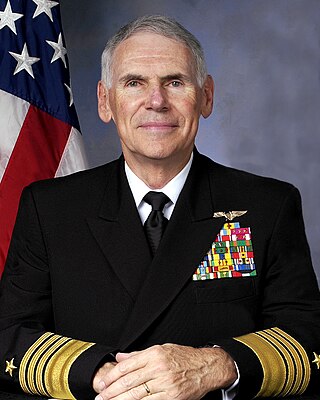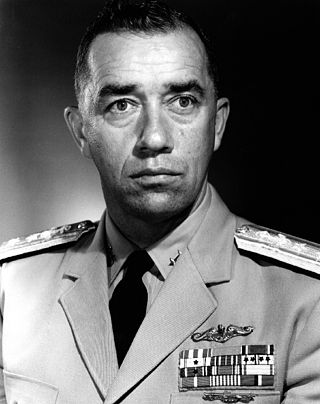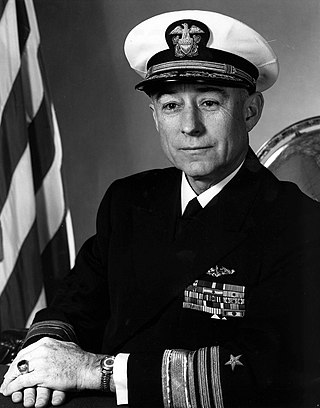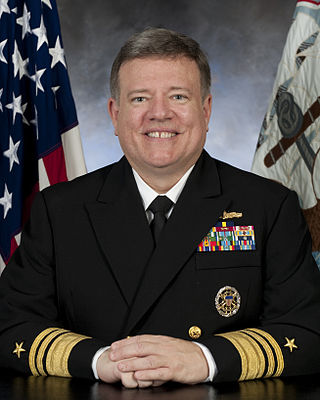
William Joseph Fallon is a retired United States Navy four-star admiral who retired after serving for over 41 years. His last military assignment was as Commander, U.S. Central Command from March 2007 to March 2008. ADM Fallon was the first Navy officer to hold that position. His other four-star assignments include Commander, U.S. Pacific Command from February 2005 to March 2007, Commander, U.S. Fleet Forces Command from October 2003 to February 2005, and 31st Vice Chief of Naval Operations from October 2000 to August 2003. On March 11, 2008, he announced his resignation from CENTCOM and retirement from active duty, citing administrative complications caused in part by an article in Esquire Magazine, which described him as the only thing standing between the Bush Administration and war with Iran.

Frank Benton Kelso II was an admiral of the United States Navy, who served as Chief of Naval Operations from 1990 to 1994.

Timothy John Keating is a retired United States Navy admiral. During his career, he served as commander of Carrier Group Five, the United States 5th Fleet, the United States Northern Command and North American Aerospace Defense Command (NORAD), and United States Pacific Command. He retired in 2009 after more than 38 years of service. He was the first navy officer to head Northern Command and NORAD.

Glynn Robert Donaho, nicknamed "Donc", was a United States Navy officer known principally for his exploits as a submarine commander during World War II, for which he received the Navy Cross four times, the Silver Star twice, and the Bronze Star Medal.

Michael Harold "Mike" Miller is a former vice admiral in the United States Navy, and was the first active-duty officer to direct the White House Military Office. He was the 61st Superintendent of the United States Naval Academy.

Bernard Ambrose Clarey, nicknamed "Chick", was an admiral of the United States Navy. A submarine commander during World War II, he served during the late 1960s as Vice Chief of Naval Operations and in the early 1970s as Commander in Chief, U.S. Pacific Fleet.

Jonathan William Greenert is a former United States Navy admiral who served as the 30th Chief of Naval Operations from September 23, 2011, to September 18, 2015. He previously served as the 36th Vice Chief of Naval Operations from August 13, 2009, to August 22, 2011. Prior to that, he served as Commander, U.S. Fleet Forces Command from September 29, 2007, to July 29, 2009, deputy chief of Naval Operations for Integration of Capabilities and Resources from September 2006 to September 2007, and commander of U.S. Seventh Fleet from August 2004 to September 2006. He retired from the navy after over 40 years of service. In March 2016, the National Bureau of Asian Research announced that Greenert would become the third holder of the John M. Shalikashvili Chair in National Security Studies at NBR. In April 2016, Greenert was appointed to the board of directors for BAE Systems for a three-year term.

Eugene Parks "Dennis" Wilkinson was a United States Navy officer. He was selected for three historic command assignments. The first, in 1954, was as the first commanding officer of USS Nautilus, the world's first nuclear-powered submarine. The second was as the first commanding officer of USS Long Beach, America's first nuclear surface ship. The third was in 1980 when he was chosen as the first President and CEO of the Institute of Nuclear Power Operations (INPO) from which he retired in 1984.

Commander, U.S. Fleet Forces Command (COMUSFF/COMFLTFORCOM) is the title of the United States Navy officer who serves as the commanding officer of the United States Fleet Forces Command. The U.S. Fleet Forces Command was originally established in 1905 as the U.S. Atlantic Fleet and as a two-star rear admiral's billet; the position has been held by a four-star admiral since March 10, 1915. The 45th, and current, commander of U.S. Fleet Forces Command is Admiral Daryl L. Caudle.

Vice Admiral Allan Rockwell McCann, was a United States Navy officer who served in World War I and World War II.

Admiral James Fife Jr. was a United States Navy admiral who was promoted to four star rank after retirement as a "tombstone admiral".

Lynde Dupuy McCormick was a four-star admiral in the United States Navy who served as vice chief of naval operations from 1950 to 1951 and as commander in chief of the United States Atlantic Fleet from 1951 to 1954, and was the first supreme allied commander of all NATO forces in the Atlantic.

Thomas John Kilcline Jr. is a retired vice admiral of the United States Navy who served as Commander, Naval Air Forces from June 22, 2007, to July 1, 2010.

Rear Adm. Jonathan Alex Yuen is a retired American admiral, who last served as the 47th Chief of Supply Corps and Commander of the Naval Supply Systems Command.

Bernard Lige Austin was a Vice Admiral of the United States Navy. His career included service in World War II, the Korean War, and the Cold War and command of submarines and surface ship forces, during which he became a distinguished combat commander of destroyers. He also commanded the United States Second Fleet, held numerous diplomatic, educational, and administrative staff positions, and a served a lengthy tour of duty as President of the Naval War College.

Peter Hasten Daly is a retired United States Navy vice admiral who served as Deputy Commander and Chief of Staff, U.S. Fleet Forces Command. He is currently the CEO of the United States Naval Institute.

Vice Admiral John Jay Donnelly is a retired American submarine officer. A graduate from the U.S. Naval Academy class of 1975, he retired in 2010 after 35 years of service.

Christopher Watson Grady is a United States Navy admiral who serves as the 12th vice chairman of the Joint Chiefs of Staff since December 20, 2021. He most recently served as the commander of United States Fleet Forces Command and United States Naval Forces Northern Command from May 2018 to December 2021, with additional duties as commander of United States Naval Forces Strategic Command and Joint Force Maritime Component Commander from February 2019. He previously served as commander of the United States Sixth Fleet, commander of Naval Striking and Support Forces NATO, deputy commander of United States Naval Forces Europe - Naval Forces Africa and Joint Force Maritime Component Commander Europe from October 2016 to March 2018.

Charles Anthony "Chas" Richard is a retired United States Navy admiral who served as the 11th commander of United States Strategic Command. He previously served as Commander Submarine Forces, Submarine Force Atlantic and Allied Submarine Command.

William Rhode Merz is a retired United States Navy vice admiral who last served as deputy chief of naval operations for operations, plans and strategy from August 6, 2021 to October 7, 2022. He previously served as commander of Seventh Fleet from September 12, 2019 to July 8, 2021.





















